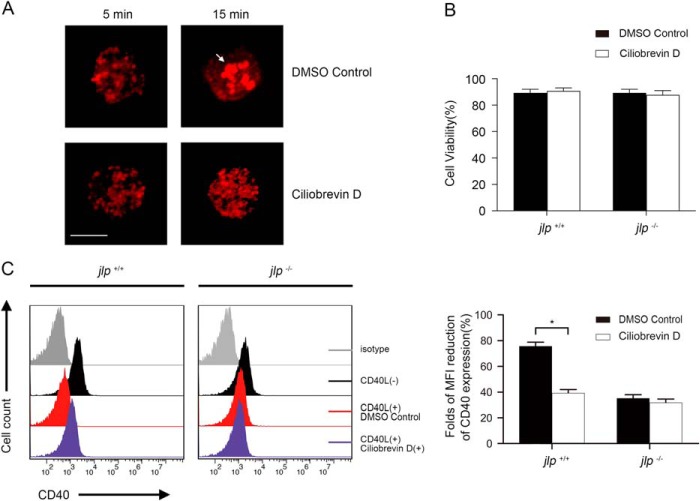FIGURE 4.
CD40 internalization in B lymphocytes is mediated via a JLP- and dynein-dependent process. A, efficiency of ciliobrevin D treatment in dynein inhibition. Purified splenic B lymphocytes were pretreated with a dimethyl sulfoxide (DMSO) control or ciliobrevin D for 30 min. Cells were then stimulated with rat anti-mouse IgM monoclonal antibody (antigen, 2 μg/ml) for 5 and 15 min, respectively, and stained for fluorescence-conjugated donkey anti-rat secondary antibody before visualization with a microscope. The arrow indicates antigen gathering. Experiments were performed in triplicate, and representative results are shown. Scale bar = 5 μm. B, ciliobrevin D treatment caused no cytotoxicity in splenic B lymphocytes. Cells were pretreated with ciliobrevin D under the indicated conditions, and cell viability was assessed by trypan blue staining. The quantitation provided combines three independent experiments. C, purified splenic B lymphocytes from jlp+/+ and jlp−/− mice were first activated with LPS (1 μg/ml) for 24 h. Activated B lymphocytes were then left untreated (red) or were pretreated with ciliobrevin D (50 μm) for 30 min (purple), with or without further CD154 cross-linking for 15 min (black). Cells were washed three times with binding buffer to exclude residual rCD154, stained with anti-CD19 and anti-CD40 antibodies, and analyzed by flow cytometry. Negative controls (gray) were stained with an irrelevant isotype-specific antibody. The histograms show surface expression of CD40 on gated CD19+ B lymphocytes. One representative experimental result of three is shown. The CD40 MFI for each indicated group was calculated by flow cytometry. Means ± S.D. were calculated from three independent experiments. Error bars indicate S.D. *, p < 0.05 (Student's t test).

